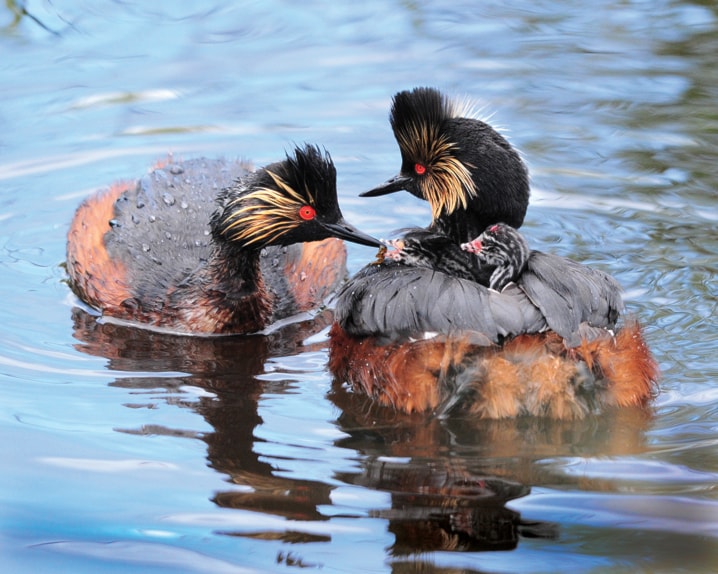The wetland bisected by Range Road 281, just west of the city, is very productive. In recognition of the many sora rails that call this area home, Red Deer’s most enthusiastic birdwatcher, Judy Boyd, has dubbed the area “Sora Central.”
The wetland also supports healthy populations of ducks, coots, snipes and terns. The road, often muddy and rutted, is especially interesting for naturalists because the traffic is light and wildlife can be seen at close range in the water-filled ditches.
In early June, local birders were delighted and surprised to spot a pair of eared grebes nesting near the west fence line.
I returned several times after the nest was found, binoculars and camera in hand. The grebes soon grew accustomed to my presence and paid me no heed as long as I remained in my vehicle.
I was awestruck by their blood-red eyes and the upsweep of their yellow, perfectly coiffed ear tufts. With lobed feet attached at their posterior, these birds are wonderfully adept at swimming and diving.
Although diminutive, they are both regal and majestic.
Eared grebes — which are colony nesters — are listed as being common in Alberta, but they aren’t often seen because they tend to take up residence in the middle of shallow lakes or sloughs that are rimmed with extensive emergent vegetation.
This pair chose to nest alone and, as noted, in a rather unusual location. Interestingly, a third loner grebe was often seen skulking around the vicinity of the nest.
In mid-June, I had the privilege of observing them over a three-day period. I watched the adults fuss with their soggy nest by daubing it with grass and mud. They carefully turned their three cream-coloured eggs every few hours and took shifts incubating them.
I was especially thrilled to see one of the chicks hatch while the male stood guard atop the nest, watching intently.
How delightful it was to finally see all three tiny balls of black and white fluff riding around under the warmth of his wings. It seemed impossible that all three could fit, but they did, and all three heads would pop out just as the food arrived.
The male had the easy job, puttering his precious cargo up and down the ditch. As soon as the first young hatched, the female shifted into slave mode, tirelessly scouring the waters for invertebrates and larvae for delivery to her hungry brood.
On the afternoon of the third day, I made a detour down the road while on a nearby errand run. To my horror, I discovered the corpses of two ruddy ducks and one American coot floating in the ditch.
The grebes were nowhere to be seen. With the help of empathetic neighbours and an Alberta Fish and Wildlife Conservation Officer, we retrieved and confirmed that the birds had been shot.
We did not find the bodies of the grebes, but spent 22 shells on the ground, a patch of blood on the road near the nest, and beer cans strewn along the length of the wetland told the pathetic tale.
I returned to the site for the last time a couple of nights ago, scouring the ditches in hopes that this little family had somehow escaped the carnage. Only a couple of nervous ruddies and the lone grebe were seen.
There is little doubt that the grebes were blasted.
How can one feel anything but anger and contempt for the stupid, alcohol-addled morons who would heartlessly shoot these innocent and beautiful creatures?
Myrna Pearman is the biologist/site services manager at Ellis Bird Farm. She can be reached at mpearman@ellisbirdfarm.ca
